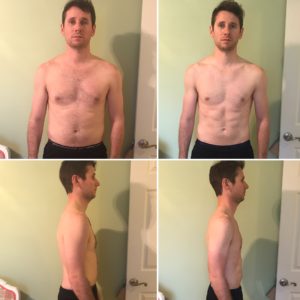
13 Mar Break Your Plateau: Are You Doing Too Much Cardio?
Swimsuit season is just a couple months away! You know you need to lose some body fat after hibernating this winter, but things seem to be a little different this year. Like way different. Like WAY harder. Before you could just skip a few meals, do cardio a few times a week and you would be fine. In fact, you’ve been exercising more than ever and it’s STILL hard AF this year. Here’s the question you have to ask yourself:
Are you doing TOO MUCH cardio?
Is that even possible?
Unfortunately, it is, and this may be part of your problem.
We generally classify quality exercise into two different categories: strength training and cardio. As our #FasterFam knows, strength training can definitely have a cardio effect if that’s the goal 😁
Strength training is challenging movements such as squats, deadlifts, rows, push-ups, crunches, and so forth. This isn’t a golden rule, but if you can do more than 20 reps, it’s probably not strength training. Strength training burns calories and increases your resting metabolic rate. It can prevent injuries and pain while building muscle to shape your ideal body type. Both Women and Men need the right amount for functional health and fitness. There is a skill component to it, but a good coach can easily teach you how to maximize the benefits of strength training and create the right amount of variety to make it fun.

Cardio is typically running, cycling, fitness classes, and the Metabolic Conditioning portions of our sessions that we have at FF. It is typically between 20 min and 2+ hours, but not limited to that. Cardio burns a lot of calories during the session, and high-intensity interval training (HIIT) burns many calories after the session as well (similar to strength training). It’s generally simple to pick up and you get that “great workout feeling”, making it a favorite for beginners. Some cardio programs can get monotonous after a while, but a good program challenges your body differently to always keep it interesting.

Now that we’re clear on the distinction between strength training and cardio, let’s answer the important question:
What is the right amount of cardio to lose body fat and stay fit?
- Sessions per week: 2-5. Ideally with strength training at the beginning of 2-3 of those sessions.
- Duration: No more than 1 hour long. Ideally, there would be a variety of different types of challenges and durations. Ex: 10 min HIITs twice a week plus strength training. Then two, 30 min sessions a week of different forms of HIITs, standard cardio and other challenges. If you have the time and energy, add a 5th day of more conventional steady state cardio such as running for 45 min. More than 5 times or 1 hour is too much cardio. Here’s some elaboration on why if you’re interested.
We recommend this because we have to remember that exercise is stressful to the body.
If you train much more than an hour, or for more than 5 hard sessions per week for months on end, your body will start to wear down. This creates a poor hormonal environment where cortisol is chronically elevated, leading to bad cravings, low energy, and handling carbs like crap. If you wear a heart rate monitor, you’ll find that you burn fewer and fewer calories per workout with most cardio over time (if your fitness level is improving). This happens because your body thinks you’re trying to be the next Lance Armstrong. It doesn’t know you’re just trying to live your best life this summer!
The key is to find the right balance of strength training, metabolic conditioning (think cardio 2.0) and following a nutrition plan that gets you to look and feel exactly how you want.
We’ve always bought into the philosophy of work smarter, not more. If your program challenges your body in different ways throughout the week and from month to month, then you should be good. You can get MORE results from working smart 45-60 minutes 3-5 times a week than someone who spends 12 hours a week working out.
In fairness, the limiting factor for most people that have hit a plateau is their nutrition intake as much as their training program. Truly, both are essential.
If your goal is to have a flat stomach or abs, there’s simply no way around eating properly year round.
Why are we confident of all this?
Because we’ve had hundreds of success stories and correlated their transformations to their training and nutrition patterns. Here are some examples of our clients that worked out just 3-4, 45-minute sessions a week and followed our nutrition plan:



At Faster Fitness we like to say that results speak for themselves. So if you’re not getting the results that you want, compare our recommendations to your current plan and take action!
If you want to learn more about how we can help you, please check out our Group Personal Training program. We have limited availability, but would love to help you make this your best summer to date. Thanks for reading!

